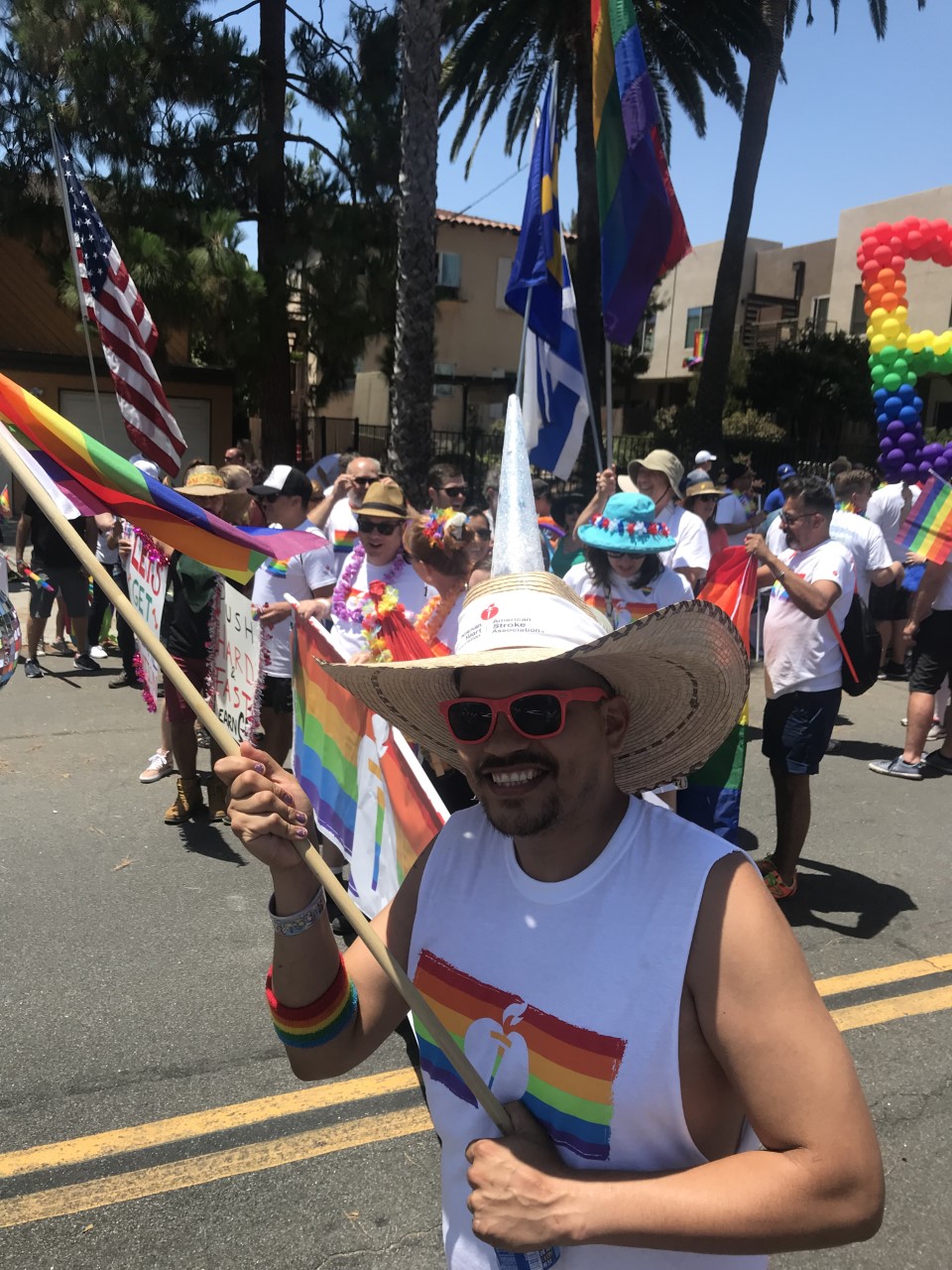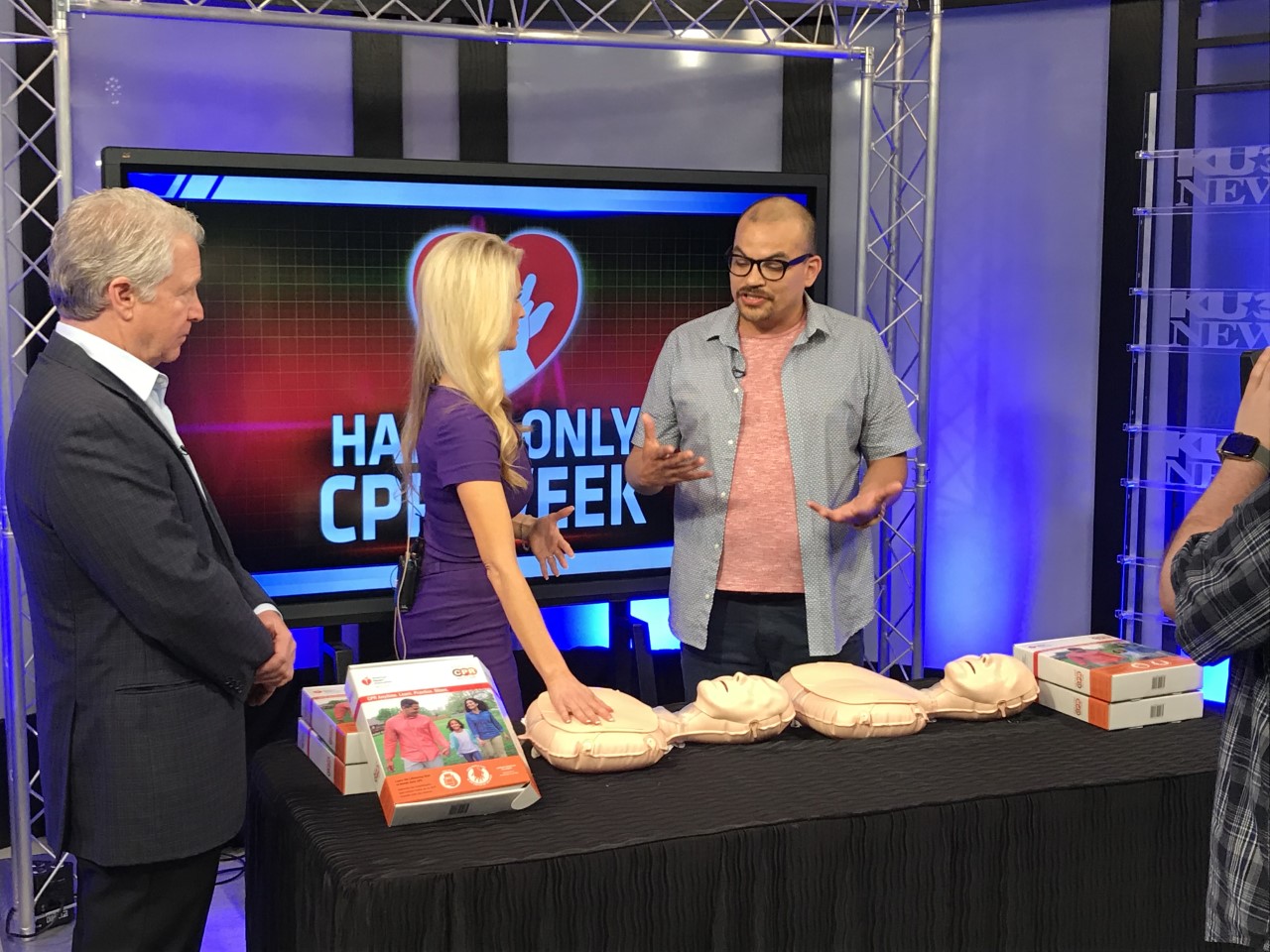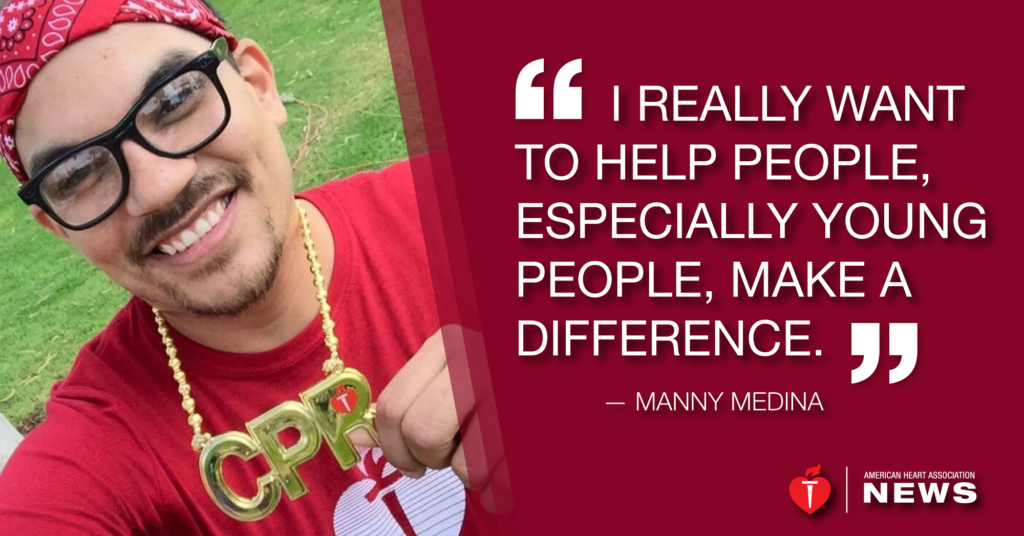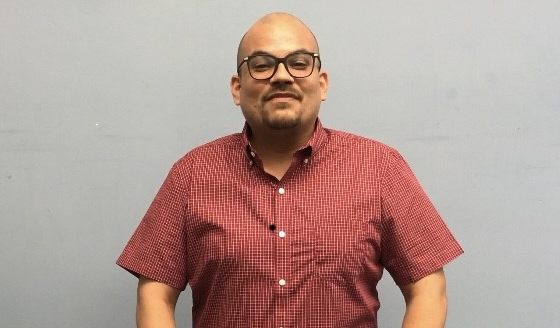There is a key local American Heart Association (AHA) volunteer who is making an impact, not only right here in San Diego, but across the country via his Health Equity and Emergency Cardiovascular Care work, especially in teaching Hands-Only CPR. Manny Medina, a trained paramedic, is the immediate past-president of the American Heart Association Western States Emergency Cardiovascular Care Committee, and is the current Chair of the Leadership Group and Program Director of the Emergency Medical Services at National University here in San Diego. Manny has been an AHA volunteer for more than a decade, taking the lead in organizing and staffing a number of community CPR trainings, including the San Diego Pride Parade. He has also been featured as the trainer in a number of CPR training videos. He has been instrumental in raising awareness and knowledge about the importance of performing CPR in a timely fashion, and is a vocal advocate for health equity.
Manny is the textbook example of what I would teach in any class I taught on what to look for in a key volunteer/catalyst. I have been looking forward to sitting down and interviewing him for LGBTQ San Diego County News for some time now, so here it goes!

ET: Introduce yourself and tell people your history of involvement with the AHA.
MM: My name is Manny Medina. I’m a paramedic and have been in emergency medicine for about 15 years. I have been working with the AHA about just as long in several different roles; I started by becoming a CPR Instructor. I did that when I was 20 years old and that really kind of got me excited about Emergency cardiovascular care and being able to save lives and how easy it was to do so.
Actually, one of my first cases (of a save) as a CPR Instructor was after one of the first classes I taught. It was a small Saturday group, when the students returned Monday to pick up their cards, one student said, “Manny, I saved somebody’s life the day after class.” He was a trainer at a gym and a 16-year-old collapsed and required CPR before paramedics arrived.
That was one of my first classes and although we don’t hear those stories as often as I would like to hear them, I thought, “Wow this is cool. This is something that I could really get into”, and so I kept doing it, and I went on to manage some training centers for the AHA.
I worked with the New Mexico Emergency Cardiovascular Care committee, where I was regional faculty for about three or four years before moving out to San Diego, where I live now. When I came to San Diego I volunteered here, and that’s where I started to get to work a lot more closely with the AHA’s Division Offices which are local offices. The people that you see in your communities, they need a lot of volunteer support, and I was new to the area and I had a passion for it already so I continued on as a volunteer on several different roles and projects. One of the first projects that I worked on was getting signatures from people to take up to the legislature to try and get a CPR bill passed in California, which would require CPR to be a high school graduation requirement in California. I collected a little over 250 signatures from health care providers, nurses, doctors, paramedics, and all the people that I was working and training with.

ET: Clearly your work has a major impact, what are some examples that stand out?
MM: I’ve worked on advocacy for the Hands Only CPR in schools, as well as tobacco cessation and sugar sweetened beverages awareness. I did a lot of work with committees and my large network to get messaging out to the people. We also highlighted survivor’s story. We were able to find over 15 survivor’s stories last year that we share with the National Center and with the Local Division offices.
We focus on Hands Only CPR trainings; we did dozens of trainings across the country and trained thousands and thousands of people.
ET: Most of what you’re sharing is about having and using your voice at the table which is allowing you to work with others to make positive impact. What are your thoughts?
MM: I think one of the things I’ve learned about myself is my voice comes from my passion and that passion is so strong because of the empowerment aspect of what I know. That is a result of being passionate about something and being able to use your voice to make changes and empower other people. I think that’s the stage that I’m at right now, as a volunteer, is really trying to empower and that’s my new role – moving from Committee Chair to Chair of the Leadership Development Committee.
It’s my job to go and find those new voices and put them into leadership roles on these national committees. To make sure that we can continue to make the impact that we need to in our communities with our voices. We need to have diversity. And so, when I’m looking at people for these positions, I also must make sure that we’re sticking to our standards for diversity and one of the things that’s included on that now is our LGBTQ+ people.

ET: Why should the LGBTQ+ community care about the work of the AHA?
MM: Even just 20 years ago it wasn’t as easy to be out and proud and that’s changed in most places in the United States, and a part of that is in that we are a big part of the larger community, and we are seen!
Just drive through North Park or Hillcrest and there’s a big chunk of our city that that is focused on our LGBTQ+ community and so we’re here, we are not going anywhere, and I think it’s important that we start to not just take pride in being out but take pride in knowing that we’re a minority, and there are certain things that are going to affect us differently as that minority population. Some of us are double minorities. I come from a Mexican background so half my family is diabetic and some of the other half had heart attacks and so on. The need to be represented doesn’t change neither does the need to have the right information that we require to be healthy.
I always go back to those words of passion is a voice and voice leads to empowerment and changes. We are at that point now where we have several generations of LGBTQ+ communities. Things are changing. We are learning a lot within our own communities about each other. You must start first with that passion and like I always tell my students, “If you’re going to do something be passionate about it, and if you recognize that passion, run with it, because that’s going to lead to, not just happiness for myself, but also for our community.”
If I were to tell our community anything, it would be that there is a seat at the table. And it’s up to us to use our passion and voice to get to help make the changes that we want to make, to help make the changes that we recognize we need to make. I would like to empower everyone to use their voice and that passion to create positive change in our community. The heart healthy choice is not always the easy choice, but the more we learn and share, their easier it becomes.
Being active and living long and strong healthy lives is really what the goal is for the AHA and I think our community’s now learning that we can live long healthy strong lives, unlike even a decade ago, that was not the case and being represented is only going to happen is if we put ourselves in those in those places to get the information and to not just be in our community but be leaders in our community. And now we need to dig in and start to look at the individual things we do. We need to make sure people understand why their choices matter and how those choice are impacting their health and communities.
There are higher risk factors in certain communities, and the LGBTQ+ community has seen that with tobacco use and hypertension for example (among the obvious other harmful things). But as we look at our 2030 goals, making sure that we are engaging these populations that are at a higher risk is one of the most sure-fire ways that we can make sure that we are reducing the death and disability from heart disease. One of the things that I’ve heard the AHA is doing is not just lumping us all as one, but really trying to get in and see who these subpopulations are and what risk factors they have and how the AHA could contribute in helping fix the problems. The AHA is making sure the LGBTQ+ community is considered as part of the population.

The AHAs desire to focus on the LGBTQ+ community led to involvement in the Pride parade and festival, AHA has already reserved space for Pride 2022. Aside from the parade, there is an AHA booth at the festival, which is kind of my thing (I like to go around and set up at festivals and events and street fairs and anywhere that I can get face to teach people CPR). It’s important to have a presence at Pride knowing AHA’s involvement started from a small focus group and is now involved in Prides across the country.
Eric Thompson
Senior Director, Communications & Marketing
American Heart Association









